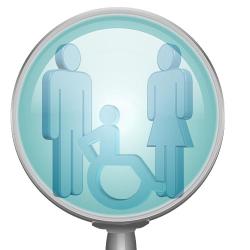Source Institutions
Source Institutions
Add to list Go to activity
Activity link broken? See if it's at the internet archive

Learners participate in a variety of activities modeling different disabilities. They use different adaptive devices (e.g., crutches, wheelchair) to see how they have been designed by engineers to be helpful to people with disabilities. After discussing their experiences, students work in teams to design or improve on an adaptive device. This activity is a good opportunity to discuss the role of biomedical and mechanical engineers.
- 10 to 30 minutes
- 45 to 60 minutes
- $1 - $5 per group of students
- Ages 11 - 14
- Activity, Lesson/Lesson Plan
- English
Quick Guide
Materials List (per group of students)
- Penny
- Tape
- Zipper / jacket with zipper
- A few pairs of latex gloves or any other thin pair of gloves
- Shirt / coat with buttons
- Child proof medicine bottles
- Eye charts
- Three pairs of eyeglasses
- Sticky notes
- Picture for puzzle
- Guitar case and/or large suitcase or a big cardboard box
- Large books that can be dropped
- Brooms (2-4)
- Stopwatch
- Assistive and adaptive devices for introduction to lesson
- Wheelchair (2 if convenient)
- Crutches (2-5 sets of various sizes)
Subjects
-
Engineering and Technology
-
Engineering
- Bioengineering/Biomedical Engineering
- Mechanical Engineering
-
Engineering
-
Life Sciences
-
Human Body
- Skeleton
- Muscles and Skin
-
Human Senses and Perception
- Vision
-
Human Body
-
The Nature of Science
- Science as a Career
-
The Nature of Technology
-
Technology and Society
- Impacts of Technology
-
The Design Process
- Invention and Innovation
- Problem Solving
-
Technology and Society
Informal Categories
- Physical Activity
Audience
To use this activity, learners need to:
- see
- be mobile
- touch
Learning styles supported:
- Uses STEM to solve real-world problems
- Involves hands-on or lab activities
Other
Components that are part of this resource:
Includes alignment to state and/or national standards:
This resource is part of:
Access Rights:
- Free access
By:
- K-12 Outreach Office, Worcester Polytechnic Institute
Source Collection
- TeachEngineering
Rights:
- All rights reserved, Regents of the University of Colorado, 2005
